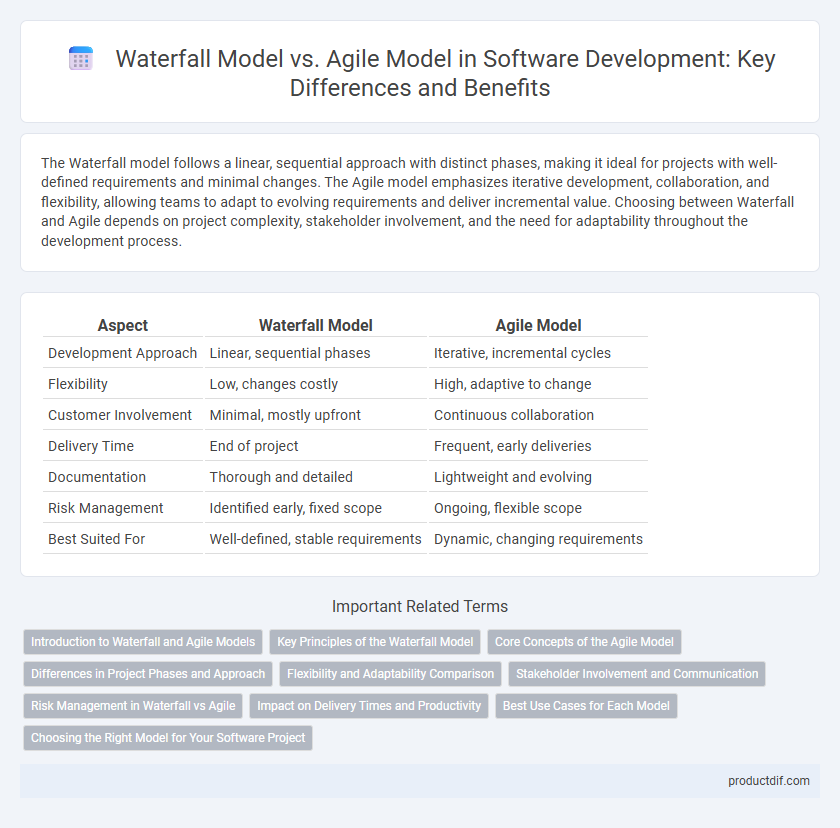The Waterfall model follows a linear, sequential approach with distinct phases, making it ideal for projects with well-defined requirements and minimal changes. The Agile model emphasizes iterative development, collaboration, and flexibility, allowing teams to adapt to evolving requirements and deliver incremental value. Choosing between Waterfall and Agile depends on project complexity, stakeholder involvement, and the need for adaptability throughout the development process.
Table of Comparison
| Aspect | Waterfall Model | Agile Model |
|---|---|---|
| Development Approach | Linear, sequential phases | Iterative, incremental cycles |
| Flexibility | Low, changes costly | High, adaptive to change |
| Customer Involvement | Minimal, mostly upfront | Continuous collaboration |
| Delivery Time | End of project | Frequent, early deliveries |
| Documentation | Thorough and detailed | Lightweight and evolving |
| Risk Management | Identified early, fixed scope | Ongoing, flexible scope |
| Best Suited For | Well-defined, stable requirements | Dynamic, changing requirements |
Introduction to Waterfall and Agile Models
The Waterfall model is a linear and sequential software development process where each phase must be completed before the next begins, emphasizing thorough documentation and fixed requirements. In contrast, the Agile model promotes iterative development, flexibility, and continuous collaboration, allowing teams to adapt quickly to changing project needs. Agile frameworks like Scrum and Kanban enable frequent delivery of functional software, enhancing customer feedback integration throughout the development lifecycle.
Key Principles of the Waterfall Model
The Waterfall Model is characterized by a linear, sequential approach with distinct phases such as requirements analysis, system design, implementation, testing, and maintenance. Each phase must be completed before the next begins, emphasizing thorough documentation and upfront planning. This model's key principles include a fixed scope, defined deliverables at each stage, and minimal client involvement during development.
Core Concepts of the Agile Model
The Agile Model emphasizes iterative development, where requirements and solutions evolve through collaboration between cross-functional teams and stakeholders. It promotes adaptive planning, continuous feedback, and early delivery of functional software, enhancing flexibility and responsiveness to change. Core practices include sprints, daily stand-ups, and user stories, enabling rapid iteration and improved product quality.
Differences in Project Phases and Approach
The Waterfall Model follows a linear and sequential project phase approach, where each phase such as requirements, design, implementation, testing, and maintenance must be completed before moving to the next. In contrast, the Agile Model employs iterative and incremental phases, allowing for continuous development, testing, and feedback throughout the project lifecycle. Agile prioritizes flexibility and adaptability, enabling teams to respond to changing requirements quickly, while Waterfall emphasizes a structured and fixed progression of phases.
Flexibility and Adaptability Comparison
The Agile model offers superior flexibility and adaptability by enabling iterative development and continuous feedback, allowing teams to respond swiftly to changing requirements. In contrast, the Waterfall model follows a linear and rigid sequence of phases, limiting the ability to incorporate changes once a stage is completed. Agile's emphasis on collaboration and incremental delivery makes it more suited for dynamic projects with evolving customer needs.
Stakeholder Involvement and Communication
The Waterfall Model features limited stakeholder involvement, primarily engaging them during initial requirements gathering and final delivery phases, which may lead to communication gaps and delayed feedback. In contrast, the Agile Model emphasizes continuous stakeholder engagement through regular iterations, daily stand-ups, and sprint reviews, fostering transparent communication and swift adaptation to changes. This iterative collaboration in Agile promotes higher stakeholder satisfaction and project alignment.
Risk Management in Waterfall vs Agile
Risk management in the Waterfall model is primarily reactive, with potential risks identified and addressed mostly during the initial planning and testing phases, making it less flexible to changing requirements. In contrast, Agile incorporates continuous risk assessment through iterative development cycles and frequent stakeholder feedback, enabling early detection and mitigation of risks. Agile's adaptive approach reduces the likelihood of costly project failures compared to Waterfall's linear and sequential process.
Impact on Delivery Times and Productivity
The Waterfall Model, characterized by its linear and sequential phases, often results in longer delivery times due to the requirement of completing each stage before moving to the next, which can delay feedback and adjustments. In contrast, the Agile Model promotes iterative development and continuous collaboration, significantly enhancing productivity and accelerating delivery by enabling frequent releases and rapid response to changes. Consequently, Agile methodologies are favored in dynamic software environments for their ability to reduce time-to-market and improve team efficiency.
Best Use Cases for Each Model
The Waterfall Model is best suited for projects with well-defined requirements and where changes are unlikely, such as in construction software or regulatory compliance systems, ensuring thorough documentation and structured progress. Agile Model excels in dynamic environments like web development and startups, where iterative feedback and frequent releases enable rapid adaptation to changing user needs. Choosing the right model depends on project complexity, flexibility requirements, and stakeholder involvement.
Choosing the Right Model for Your Software Project
Selecting the appropriate development methodology depends on project scope, timeline, and flexibility requirements. Waterfall model suits projects with well-defined, fixed requirements and a linear progression, ensuring structured documentation and milestone tracking. Agile model excels in dynamic environments, promoting iterative development and continuous stakeholder feedback for adaptive, faster delivery.
Waterfall Model vs Agile Model Infographic

 productdif.com
productdif.com